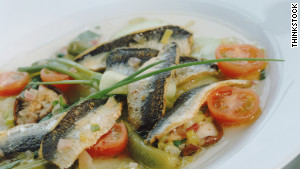 The arrival of the New year is meant
for feasting. To sit down and share a
meal with family and friends to usher in a year of prosperity. Here are some of the common food traditions
around the world and a few hints about where to partake in them:
The arrival of the New year is meant
for feasting. To sit down and share a
meal with family and friends to usher in a year of prosperity. Here are some of the common food traditions
around the world and a few hints about where to partake in them:
Hoppin' John, American South
A major New Year's food tradition in the American
South, Hoppin' John is a dish of pork-flavored field peas or black-eyed peas
(symbolizing coins) and rice, frequently served with collards or other cooked
greens (as they're the color of money) and cornbread (the color of gold). The
dish is said to bring good luck in the new year.
Twelve grapes, Spain
While Americans watch the ball drop in Times Square
on New Year's Eve, Spaniards watch the broadcast from Puerta del Sol in Madrid,
where revelers gather in front of the square's clock tower to ring in the New
Year. Those out in the square and those watching at home partake in an unusual
annual tradition: at the stroke of midnight they eat one grape for every toll
of the clock bell. Some even prep their grapes -- peeling and seeding them --
to make sure they will be as efficient as possible when midnight comes.
Tamales, Mexico
Tamales, corn dough stuffed with meat, cheese and
other delicious additions and wrapped in a banana leaf or a corn husk, make
appearances at pretty much every special occasion in Mexico. But the holiday
season is an especially favored time for the food. In many families, groups of
women gather together to make hundreds of the little packets -- with each
person in charge of one aspect of the cooking process -- to hand out to
friends, family and neighbors. On New Year's, it's often served with menudo, a
tripe and hominy soup that is famously good for hangovers.
Oliebollen, Netherlands
In the Netherlands, fried oil balls, or oliebollen,
are sold by street carts and are traditionally consumed on New Year's Eve and
at special celebratory fairs. They are doughnut-like dumplings, made by
dropping a scoop of dough spiked with currants or raisins into a deep fryer and
then dusted with powdered sugar.
Marzipanschwein or Glücksschwein, Austria
and Germany
Austria, and its neighbor to the north, Germany,
call New Year's Eve Sylvesterabend, or the eve of Saint Sylvester. Austrian
revelers drink a red wine punch with cinnamon and spices, eat suckling pig for
dinner and decorate the table with little pigs made of marzipan, called
marzipanschwein. Good luck pigs, or Glücksschwein, which are made of all sorts
of things, are also common gifts throughout both Austria and Germany.
Soba noodles, Japan
In Japanese households, families eat buckwheat soba
noodles, or toshikoshi soba, at midnight on New Year's Eve to bid farewell to
the year gone by and welcome the year to come. The tradition dates back to the
17th century, and the long noodles symbolize longevity and prosperity. In
another custom called mochitsuki, friends and family spend the day before New
Year's pounding mochi rice cakes. Sweet, glutinous rice is washed, soaked,
steamed and pounded into a smooth mass. Then guests take turns pinching off
pieces to make into small buns that are later eaten for dessert.
King cake, around the globe
 The tradition of a New Year's cake is one that spans
countless cultures. The Greeks have the Vasilopita, the French the gateau or
galette des rois. Mexicans have the Rosca de Reyes and Bulgarians enjoy the
banitsa.
The tradition of a New Year's cake is one that spans
countless cultures. The Greeks have the Vasilopita, the French the gateau or
galette des rois. Mexicans have the Rosca de Reyes and Bulgarians enjoy the
banitsa.
Cotechino con lenticchie, Italy
Italians celebrate New Year's Eve with La Festa di
San Silvestro, often commencing with a traditional cotechino con lenticchie, a
sausage and lentil stew that is said to bring good luck (the lentils represent
money and good fortune) and, in certain households, zampone, a stuffed pig's
trotter.
Pickled herring, Poland and Scandinavia
Because herring
is in abundance in Poland and parts
of Scandinavia, and because of their silver coloring, many in those nations eat
pickled herring at the stroke of midnight to bring a year of prosperity and
bounty. Some eat pickled herring in cream sauce, some have it with onions.
Kransekage, Denmark and Norway
Kransekage, literally wreath cake, is a cake tower
composed of many concentric rings of cake layered atop one another, and they
are made for New Year's Eve and other special occasions in Denmark and Norway.
The cake is made using marzipan, often with a bottle of wine or Aquavit in the
center and can be decorated with ornaments, flags and crackers.
Credit: http://edition.cnn.com/2012/12/28/travel/new-years-food-traditions/index.html


No comments:
Post a Comment